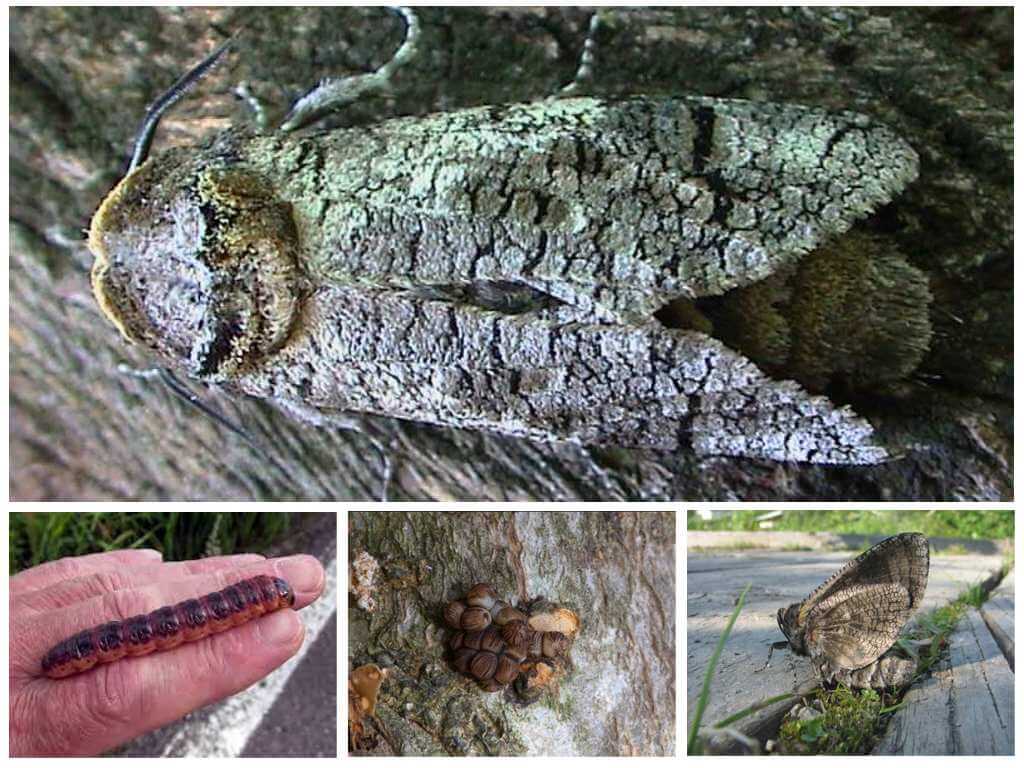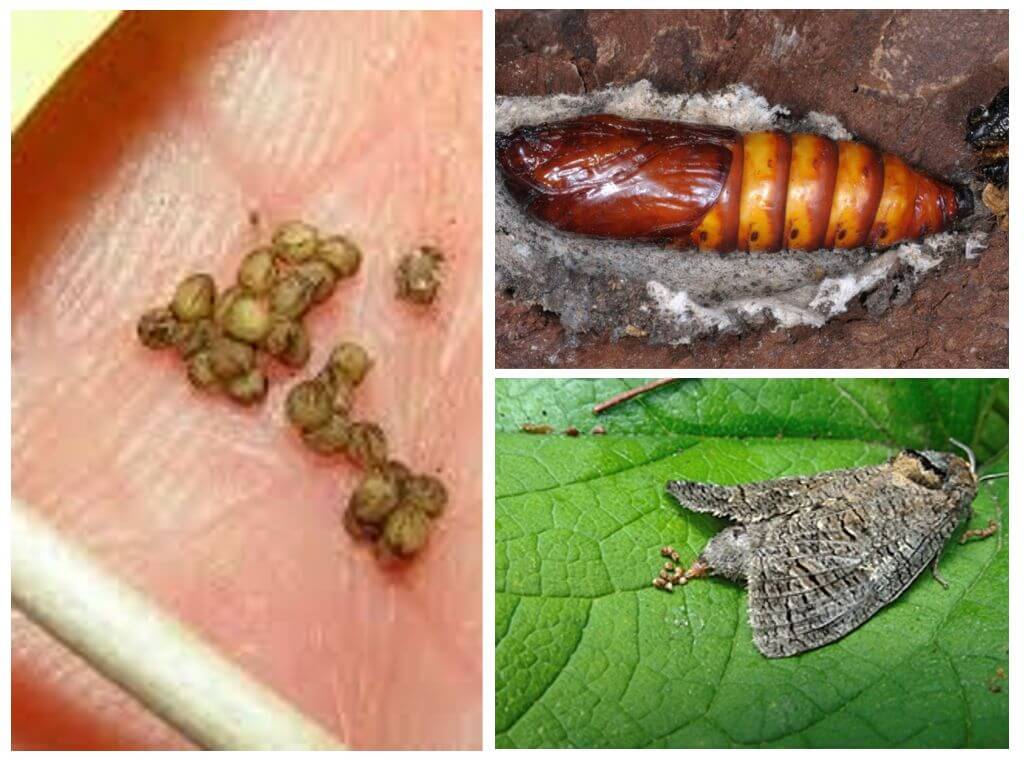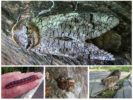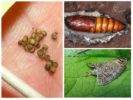- Woody odorous
- Smelling eggs and larvae
Appearance at different stages of development
The insect belongs to the order Lepidoptera or butterflies. An adult leads a nocturnal lifestyle. The front wings mimic the pattern of the tree bark, which allows the butterfly to remain invisible. Hind wings slightly darker, transversely striated. The chest of the insect has a characteristic pattern. The appearance of the mask gives it a graduation of color - dark at the top, it brightens closer to the abdomen. A black horizontal stripe divides the chest into two uneven parts.
A rare feature in moths is the lack of a mouthpart. The odorous wood-wearer does not feed, but lives off of the reserves that it accumulates in the caterpillar stage.
As with all nocturnal moths, the willow woodworm has well-developed sense of smell. The sensilla are localized on the surface of the antennae.
Hearing organs are located on the basis of the abdomen or in the area of the posterior thorax. The odorous scavenger perceives high-frequency sounds and ultrasound, which allows him to respond to the approach of bats.

The abdomen of the butterfly is oblong, thick, with well-defined segments. On the outer edge of the segments a thick gray pubescence is seen. Scales in the form of hairs cover the entire body of the imago, except for complex faceted eyes.
The size of an adult female is slightly larger than the male. The gender of the butterfly can be distinguished not only in size, but also due to the clearly visible ovipositor moving out of the abdomen.
A large, heavy butterfly flies low above the ground. In the evening and at night, she crawls along a tree trunk. Folding the front wings with a hut, the insect protects the abdomen with them, which makes it indistinguishable against the background of folds of the bark.
The caterpillar is large, bright. The color of the chitinous cover changes with age. Young individuals are pink. Gradually the caterpillar darkens, acquiring a reddish-brown or cherry color with a darker back. The body is covered with rare hairs. The head is black, equipped with powerful mandibles - jaws, at the base of which are glands that secrete a secret with a strong smell of wood vinegar.
Pupa reddish-brown with a light yellowish abdomen.
Features of reproduction and development
The entire cycle of transformation of the odorous wood-tree takes place in two years. Adult adults begin years depending on air temperature. In the middle zone of Europe, summer begins in late May and continues until early August. In the warm south, the first butterflies appear in April, and in the cold north at the end of June. This period lasts about 14-16 days.
After fertilization, the female lays 300-1400 eggs, in heaps of several tens. The female takes care of the offspring only in the egg phase. It covers eggs from above with the rapidly hardening in the air secretion of the accessory glands. The egg phase lasts 1.5-2 weeks. The masonry is located in the butt part of the trunk, in folds and cracks of the bark.

Young caterpillars emerging from them bite into the bark, forming a broad common passage above the bast. Growing up, caterpillars damage the bast and cambium, gnawing interconnected passages that are filled with fine wood dust and excrement. According to brown discharge, it becomes clear how to find an odorous woodworm. Having wintered for the first time, adult caterpillars go deep into the trunk, gnawing wide oval passages directed upward from the base of the trunk.
Important!
The caterpillar of the odorous woodworm of the first wintering does not leave the tree. It can be noticed only when cutting the tree or it will detect the outer openings of the passages. If you sniff, the presence of a caterpillar gives off a pungent odor. Adults can occasionally be seen on the ground when large, up to 8-12 cm caterpillars crawl in search of a place for pupation.
The fragrant woodworm in the photo is shown below at the stage of the caterpillar and butterfly.
Between May and June, caterpillars pupate, forming a dense cocoon of sawdust around them, in the same place where they wintered, or crawling into the soil. Silk threads form the base of the cocoon, into which willow woodworm weaves tiny lumps of soil or drill flour. Pupa develops within 2-6 weeks. After which, the half-length pupa protrudes from the cocoon.
Thus, the odorous wood-tree passes through 4 stages in two years:
- Egg - 12-16 days;
- Larva is a caterpillar;
- Pupa - 2-6 weeks;
- Adult or butterfly - 2 weeks.
The most harmful to green spaces odorous woodworm does at the stage of the larva.
Pest Management Methods
Trees, favored by woodworkers, get sick, and with mass settlement they can die. This rarely happens, but in order to prevent damage to fruit trees, the stems are whitened with a special emulsion that protects the bark from cracking and the introduction of larvae. The outer openings of the passages are filled with cotton balls soaked in an insecticide, or liquid is injected into the cavity. From above, the hole is covered with garden varieties, a mixture of clay and slaked lime.
Carry out mechanical cleaning of the trunks from the fallen off bark and caterpillars. Damaged branches are cut. If the tree is badly damaged, then it is removed, and the collected caterpillars are burned.
Interesting!
Despite the wide range of distribution, in some countries the odorous woodworm is listed in the Red Book. Fishermen with pleasure collect caterpillars, as catfish are great for them. They are not easy to find and cannot be collected with your bare hands, but even from a damaged larva you can prepare an attractant for fishing.
Some insect lovers grow woodworms at home because of large and vibrant caterpillars. Despite the fact that willow treeworm is a pest, it is interesting to study it as one of the largest species of nocturnal moths.





